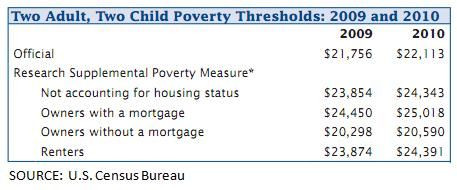New Methodology Points to Higher Poverty Threshold

The U.S. Census Bureau is experimenting with a new method of determining poverty in America, including additional factors like medical expenses, tax credits, government benefits like food stamps, housing subsidies and school lunch programs, and cost-of-living adjustments for different geographic areas.
The so-called Supplemental Poverty Measure found a higher poverty threshold, setting the line at $24,343 for a two-adult, two-child family. The 2010 poverty line was $22,113.
The poverty thresholds, updated annually by the Census Bureau to reflect price changes, are used to prepare estimates of the number of Americans in poverty each year.
While the size of America’s population living in poverty differs only modestly between the official and supplementary counts, demographic discrepancies emerge. For example, 3.2 million fewer children under age 18 are counted as poor, and new poverty rates increased substantially among the elderly.
The alternative measure is not intended to replace the official poverty measure or to determine eligibility for government programs; it is purely supplemental for now.
Published by Medicaldaily.com



























